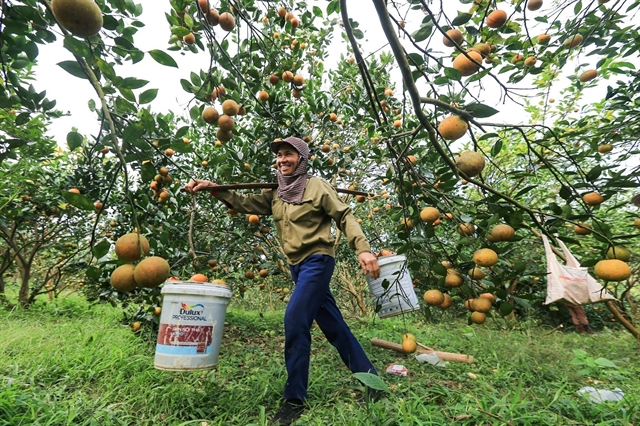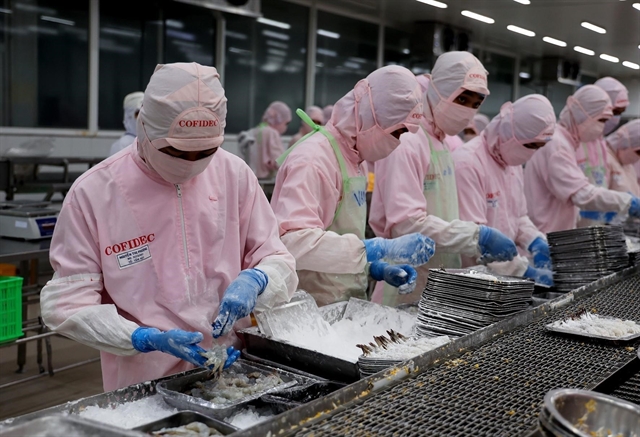 Opinion
Opinion


|
| A woman from Cao Phong District in Hòa Bình Province carries buckets of oranges. The district is home to 1,500 ha of orange cultivation with total output of 18,000 tonnes. VNA/VNS Photo Trọng Đạt |
In a recent interview with Vietnam News Agency, Minister of Agriculture and Rural Development Lê Minh Hoan talked about the achievements of Việt Nam’s agriculture sector and plans for 2023. The interview has been edited for length and clarity.
Multiple global fluctuations affected Việt Nam’s agriculture sector in 2022. How do you evaluate the achievements of the sector in the last year?
In 2022, the country’s agriculture encountered many challenges caused by the pandemic, supply chain disruption, and rising logistics and input costs. Though it didn't meet our expectations, they were some things that we are proud of.
It’s not in the statistics but in the intangible value. With its supporting pillar role, agriculture has contributed to the overall growth of the economy.
Currently, many countries are suffering food security crises, with some experiencing disrupted supply chains. However, the agriculture sector of Việt Nam remains strong. In the final half of 2022, many countries reached out to Việt Nam for cooperation opportunities to ensure food security.
As Minister of Agriculture and Rural Development, you introduced the policy to shift from agricultural production to agricultural economy. How has this been done?
We can see that both farmers and businesses have changed their mindset about agriculture.
Also, the time when the goal centres around just productivity, has gone. There has been more focus on how to create added value, instead of merely emphasising productivity.
“Less is more” and “more from less” are the global trends now.
In 2022, agriculture, forestry, and fishery exports continued to hit record highs. The sector has also been successful in diversifying markets. What should localities, businesses and farmers do to maintain these good results?
Việt Nam has qualified to export its agricultural products to many tough markets as well as has made efforts to diversify its products. It proved that the quality of Việt Nam’s agricultural produce meets even the toughest markets.
Businesses have also targeted high-end markets to make bigger profits. Market-oriented mindset has been adopted. Many businesses and farmers now produce and sell what buyers need.
Many local rice exporters have offered products based on specific requirements of specific markets. Thanks to this, farmers can ensure the quality from the first stage of choosing suitable breeds to the cultivation procedures. The vision of businesses (exporters) will help farmers a lot.
The Ministry of Agriculture and Rural Development and the Ministry of Industry and Trade have hosted several forums to help businesses stay mindful of the different requirements of different markets. We can’t make “uniform” products but should create many segments.
Diversifying markets contribute to the stable and sustainable export of agriculture produce.
In the long term, it will create stronger linkages among the producers, between producers and exporters as well as reduce risks.
Associations, businesses and producers must ensure quality and protect their prestige. There are lots of opportunities, the thing is how we export the type of products that are of great demand.

|
| Workers at a company in Hồ Chí Minh City process shrimp for export. Việt Nam reaped US$53.22 billion from exporting agro-forestry-fishery products in 2022. VNA/VNS Photo |
Given the volatility of the global economy, what are the directions for Việt Nam’s agriculture sector in 2023 and the upcoming years?
The agriculture sector always encounters challenges, not just at this time. One of them is that the world is changing and this requires us to have plans to proactively adapt to changes. It is also a challenge for us when standards are becoming higher.
People now care about not only price and quality but also the impacts on the environment, biodiversity, and climate change during the production process. When it comes to coffee or cashew, for example, the question would be whether the cultivation is on land acquired through deforestation or not.
IUU is also an example showing that people care about not only the tastiness of seafood but related issues like how they are fished, and whether the fishing violates international laws or not.
They are pressures that require the agriculture sector to change.
Việt Nam has made commitments at COP26 to ensure both growth and environmental protection, developing its agriculture sector in a responsible and sustainable way, and participating in the global supply chain.
These commitments must be translated into specific actions, which include rearranging production activities that would create many jobs in rural areas.
In 2023, Việt Nam must strengthen the rural economy, creating many more jobs in rural areas. This requires us to change the operation of cooperatives and the way we do OCOP and agricultural tourism. VNS
Ministry achieves all goals
HÀ NỘI — The Ministry of Agriculture and Rural Development has recently announced that it has achieved all goals set for this year, including a growth rate of 3.36 per cent, a record for many recent years.
Animal husbandry and cultivation grew 2.88 per cent, fisheries by 2.88 per cent, and forestry 6.13 per cent. Việt Nam’s forest coverage reached 42.02 per cent of the country's total area.
More than 73 per cent of communes in the country met the criteria of new-style rural areas.
The export revenues of agro-forestry-fishery products reached a new record of US$53.22 billion, 9.3 per cent higher than that of 2021, with a trade surplus of over $8.5 billion.
Nguyễn Văn Việt, Director of the ministry’s Planning Department, said that the production structure of the industry continued to be adjusted more appropriately and effectively in association with the market.
The consumption market of Vietnamese farming products continues to expand in both categories and products. The domestic market has received more attention while the Government and the sector made efforts to promptly remove trade barriers, boosting the exports of agricultural, forestry, and fishery products.
It is forecast that Việt Nam’s economy will continue to face difficulties and challenges in 2023 such as inflationary pressure, a sharp increase in production costs, negative impacts of climate change, changes in demand and new consumption patterns, and especially impacts from the Russia-Ukraine conflict.
In 2023, the agriculture sector targets a growth rate of 3 per cent and export revenue of $54 billion.
It aims to have 78 per cent of communes and at least 270 districts nationwide recognised as new-style rural areas. VNS




